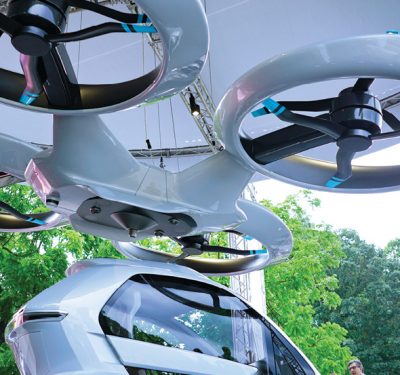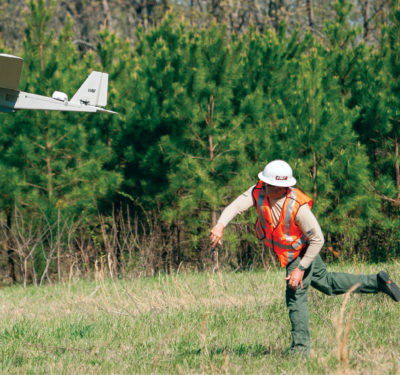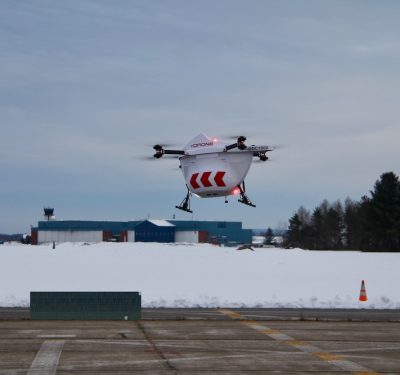
With the Notice of Proposed Rulemaking for BVLOS flights in the National Airspace System now penciled in for August 2024, the FAA is highlighting that it’s trying to grease the skids to get as many operations approved as possible.
Proposed BVLOS rules had been hoped for by as early as this fall, but now the target date is to have them out by August 2024, agency officials said at the recent FAA Drone Symposium, hosted by the FAA and AUVSI in Baltimore.
David Boulter, the FAA’s acting association administrator for aviation safety, noted the agency has produced “a couple thousand pages” of regulation so far this year, not including Part 107 exemptions, “so, that pipeline is only so big.”
Even with the delay, the agency is seeking to “lean in” to speed the exemptions process and to get a head start on future approvals for unmanned traffic management (UTM) systems and others, he said.
Boulter noted that in May the FAA published four exemption requests in the Federal Register, with questions and a request for industry comments. The exemptions were from UPS Flight Forward, which wants to fly its Matternet M2 drones from a remote operations center; Phoenix Air Unmanned, which wants to fly BVLOS for infrastructure inspections, including sometimes flying over roads and people; uAvionix, which wants to fly BVLOS for research and development with the Rapace UAS; and Zipline, which wants to replace ground observers with its detect and avoid system.
For each of these, the FAA had questions of its own, and Boulter said reviewing them will give industry insight into what may be in the final rule.
“You can take what we’re asking for in those exemptions as a signal to what we’re thinking about in rulemaking,” he said. “In a perfect world we would…we would have started this years ago, but what our goal is, is to use exemptions to signal what we’re thinking, and what we’re thinking of allowing in the rule, and then use those operations.”
For instance, as the agency posted in the Federal Register, several industry standards have been published that could define the performance of detect and avoid systems, although the solution may have to be a combination of standards.
“In which circumstances or operating environments should the FAA allow this combination approach?” the agency asked in the Federal Register. “Conversely, are there circumstances or operating environments where no combination of current standards would provide an acceptable level of safety?”
Speaking of those exemption requests, Brandon Roberts, executive director of the FAA’s Office of Rulemaking, said, “that docket closed on June 14. We got over 400 comments, we’re working through those, actually pretty expeditiously, hoping to start issuing some exemptions starting this month.”

“BVLOS IS THE PATH TO UNLOCK SCALE OPERATIONS IN A FINANCIALLY FEASIBLE MANNER.”
Eric Bergesen, director of operations, UPS Flight Forward
A representative from one of the companies seeking an exemption happened to be sitting on the stage with him at the time. And although there’s not much need to belabor the need for BVLOS at this point, Eric Bergesen, director of operations at UPS Flight Forward, summed it up.
“BVLOS is the path to unlock scale operations in a financially feasible manner,” he said. “We’ve got BVLOS with visual observers in our operations today, but from an economic standpoint, stringing together visual observers to fly more than a couple of miles just isn’t economically viable.”
He said the company has customers in the medical delivery space “that love the technology, love the capability that it brings to their organizations…they’re chomping at the bit to see us get that BVLOS capability unlocked so they can expand their operations with UAS.”
TEMPLATING
Aside from foreshadowing what it may be thinking, the FAA is also working to let birds of a feather flock together, so to speak. Boulter called it “templating,” where exemptions that are seeking to accomplish the same thing are approved together under summary grants.
“That’s a very quick process [by] our standards,” he said. “So, if you want to do something and you can do it, if it fits inside that grant, then we’ll give you a summary grant.”
The agency is seeking to get as many exemption approvals out as possible. “That just comes with a word of warning. If you want do to something unique, it’s going to take a minute. If you want to do something that’s in an existing exemption, please get it in and we’ll move it,” Boulter said. “I say to the team all the time, let’s not create pain where there’s no gain in safety.”
Derek Hufty, manager of the Special Programs Section in the Flight Standards Service, said the idea of templating came from the world of agriculture, specifically Part 137, which governs the use of aircraft and drones to spray crops.
“The 137 industry kind of figured out the summary grant, we’ll say loophole,” he said. The office was getting overwhelmed with requests, “and once we started really diving into the operations, we found out they were almost 99%…flying about 20 feet at about 20 miles an hour over private property and I think one of my bosses said…can we figure out a way to maybe process this a little bit quicker?”
The FAA didn’t need to change any statutes or regulations, just amend its flight standards bible.
“With the data we’ve had, I’m sure some 137 UAS have been put in the dirt, but no fatalities, no mid-airs [collisions], no injuries, and they’ve been doing this for eight years, hundreds and thousands of exemptions,” Hufty said. “We said, this is an acceptable level of safety to move forward…we’re not affecting safety, we’re increasing our efficiency.”
UPS Flight Forward’s Bergesen praised the move. With the current process, “We write an exemption request, package it up…we hand it over with our safety case to the FAA, and it kind of disappears into the ex parte process and we sit back and wait with bated breath,” Bergesen said. “Every time we want to change something that we’re doing, it’s back through the exemption process.”
Rulemaking will certainly streamline that, he said. But so will telegraphing what will be in the final rule and adopting summary grants, “which is a benefit to the operators, getting those exemptions out earlier.”
UTMS AND NTAP
The FAA is also turning its eyes toward what will be needed from UTM systems and other service providers in the near future. Following field tests of UTM systems led by the Virginia Tech Mid-Atlantic Aviation Partnership, the FAA now is planning a follow-up test at a site in Dallas.
“It strikes me as a perfect example of how industry has been empowered to bring solutions to deconflict and create strategic deconfliction in a way that probably the FAA wouldn’t have the resources to catch up to,” AUVSI President and CEO Brian Wynne said.
Boulter said the Dallas test could involve as many as five companies interoperating with their own methods of strategic deconfliction, something that will be necessary to scale up BVLOS flights, as creating a replica of the air traffic management system for crewed aircraft would be unworkable—any UTM for drones will need to be heavily automated.
“It’s perfect for us from an FAA air traffic perspective, because ultimately we know in this space there will be multiple players and then those players, if they’re talking to each other, then we just have to figure out how to get those talking to the air traffic system,” Boulter said.
“That’s not anything we’re building, that’s what you’re building, the folks in this room.”
The test location, called the UTM Key Site, still has a lot of unknowns associated with it, such as where exactly it will be located, when activity will start and how industry can take part.
But Praveen Raju, an FAA program manager, said it will be a community-based cooperative ecosystem complementary to the FAA’s ATM system, providing services below 400 feet—airspace where ATM isn’t provided—and to drones weighing 55 pounds or less. NASA, which has been working on UTM systems for years, will be a key player in the test.
Flight services will be provided by multiple unmanned service providers for multiple operators. Lessons learned will be provided directly to the FAA’s rulemaking team, he said. The test will also use supplemental data service providers, which can provide the location of crewed aircraft, weather updates and more.
Peter Sachs, the FAA’s UTM implementation program manager, said “we do want to get this going on the order of months to next year.”
The FAA is also looking at streamlining the way companies can use UTMs or supplemental data service providers with a the new Near Term Approvals Process, or NTAP.
“This is a pilot program that we’re working with our friends in Flight Standards and the Air Traffic Organization and others across FAA,” said Jessica Brightman, manager, Implementation Branch, UAS Integration Office. “The idea is we’re looking at a UTM service in a low-risk environment alongside a waiver or exemption approval.
“For the NTAP program, our goal is to go through a few approval processes using Part 107, using the exemption process, and review them as a standalone thing next to the other safety cases and that mitigation, so that once we get through the approval and the wavier for exemption is granted, we can then take that safety justification that we used on that particular third-party service and apply it to another waiver or exemption,” she said.
In other words, once a service provider has been approved for one waiver, it could be pre-emptively approved for others.
“Going forward, for scalability, especially on the UTM side, we can’t ask UTM providers to go through the same safety case and safety review for every customer on the operator’s side,” she said.
Speaking to Inside Unmanned Systems, Joe Morra of the FAA’s Flight Safety Leadership Team said the idea is to make services to operators “more modular.”
“We’ve been doing waivers and exemptions that utilize other services, for detect and avoid, or utilize command and control, or utilize any other type of service. The idea is, for multiple operators, should they have to individually get approved within their waiver submission or petition for exemption for re-using equipment that multiple operators are using?” he said.
“It’s where I think industry is really craving to go, so we’re looking for ways in the near term to make that approvable and potentially separate in a way that more operators could benefit from the same thing, so you don’t have to re-explain the whole criteria for that system working.”
Brightman said, “So, we’ve got these two things going on, the work in Dallas but also the near term approvals process, where in both cases we’re looking to gather data, and to learn.”
REGULATORY PATH
Boulter emphasized to an industry that’s chomping at the bit to go BVLOS that “We do our best work when we listen to what’s going on in the industry, we stay connected. Just know that behind the scenes we’re working exceptionally hard and our teams are really leaning in and saying…we need more operations, we need data, but ultimately we’ve got to do them safely, that will send us backwards if we have any kind of tragic event.”
He said his mantra to his team is the FAA has got to be responsive to industry.
“We owe you a path. It may not be the path you want to take, but we owe you a path to certification and operation into the National Airspace System.”






